I’m impressed. I found this photo of a humongous Lophophora williamsii v. caespitosa on the British Cactus and Succulent Society discussion forum.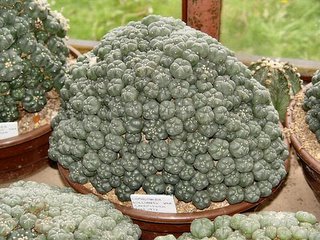
Lophophora williamsii v. caespitosa
According to the forum this amazing plant was sown back in 1972, and is just one of a batch. Unfortunately it doesn’t say when the picture was taken.
Tuesday, December 27, 2005
Lophophora williamsii v. caespitosa
Munching on Lophophora williamsii - II
My cold house grown Lophs have been maimed by some critter eating big, hearty lumps out of them. There are no traces of snails so I expect the culprit to be a grasshopper or bush-cricket trapped in the house.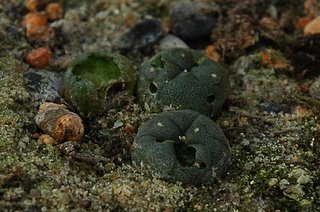
Maimed Lophophora williamsii (SB 854; Starr Co, Texas)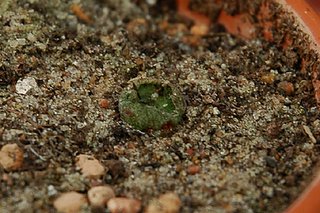
Lophophora diffusa (JR; Higuerillas, Queretaro) remains
The plants above were sown May 1, 2004 and have grown in the cold house since. Some of this year’s Lophophora seedlings were also taken out by the “unwanted guest”.
I’ve wrapped the pots in horticultural fleece and hope this will keep the culprit out in the future.
Wednesday, December 21, 2005
Winter Solstice
Today is the Winter Solstice for 2005 - the Sun is now at its lowest declination in Northern Hemisphere skies. The Sun is returning; alas, (Northern) winter is just starting.
Monday, December 19, 2005
Ariocarpus & Epithelantha
I’m just home from California, slightly worn and jet-lagged. Again I took the opportunity and ordered plants from Mesa Garden to be delivered to my US hotel address (and again the plants are immaculate).
I received the plants listed below (all in the range of 10 years old from seed) and a couple of Opuntias for my winter hardy collection. The Ariocarpus and Epithelantha plants were potted yesterday in a mix of primarily limestone gravel, some loamy sand, and a bit of commercial cactus soil.
Ariocarpus fissuratus (SB413)
Brewster County, Texas, USA
Ariocarpus fissuratus (SB413)
The plants are approximately 2.5-3 cm (~ 1-1.2’’) wide, and 6.5-7 cm (~ 2.5-2.75’’) high.
Ariocarpus retusus (SB334)
Huizache, San Luis Potosi, Mexico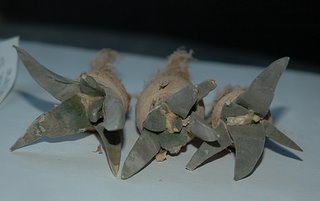
Ariocarpus retusus (SB334)
The plants are approximately 2.5-2.7 cm (~ 1’’) wide, and 7 cm (2.75’’) high.
Epithelantha bokei (SB416)
Brewster County, Texas, USA
Epithelantha bokei (SB416)
The plants are approximately 1.5 cm (~ 0.6’’) wide, and 2.2 cm (~ 0.87’’) high (measured without the root).
Tuesday, December 13, 2005
Cacti of the Trans-Pecos & Adjacent Areas
I’ve meant to buy this book for more than a year now; I finally got it ordered and received my copy a couple of days ago. I haven’t read through it all yet, just browsed the sections on Ariocarpus, Epithelantha, and Lophophora. These are excellent and very informative; I’m looking forward to have the time to read the book from end to end.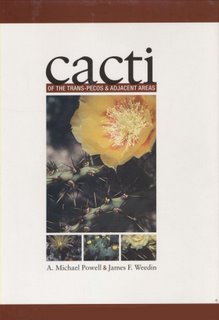 The Texas Tech University Press description reads: “Of the 132 species and varieties of cacti in Texas, about 104 of them occur in the nine counties of the Trans-Pecos region and in nearby areas. This volume includes full descriptions of those many genera, species, and varieties of cacti, with sixty-four maps showing the distribution of each species in the region.
The Texas Tech University Press description reads: “Of the 132 species and varieties of cacti in Texas, about 104 of them occur in the nine counties of the Trans-Pecos region and in nearby areas. This volume includes full descriptions of those many genera, species, and varieties of cacti, with sixty-four maps showing the distribution of each species in the region.
The descriptions follow the latest findings of cactus researchers worldwide and include scientific names; common names; identifying characters based on vegetative habit, flowers, fruit, and seeds; identification of flowerless specimens; and phenology and biosystematics.”
All Time Most Popular Posts
-
Lophophora williamsii (peyote) populations have diminished in large areas of South Texas where peyoteros harvest the cactus for ceremonial ...
-
On various occasions I've been asked what growing media I'm using for my cactus plants. I don't have a set soil mix recipe as su...
-
Below is a list of retailers/nurseries selling cactus seed and plants. I've only listed vendors I've done business with. If you ar...
-
Most cacti are easily grown from seed - and with a little patience and care they can be grown into beautiful plants. Lophophora williamsi...
-
In last month’s post on the troubled Texan peyoteros I referred to Anderson’s article on the peyote situation in Texas. Given the importanc...
-
Yet another slightly off topic and probably not entirely politically correct post, but I couldn’t help noticing the similarity of my monstr...
-
Flowering stand of San Pedro cacti (Trichocereus pachanoi) To me the main draw of the San Pedro cactus ( Trichocereus pachanoi (syn. Ech...
-
In the June 2008 issue of the Cactus & Co magazine Jaroslav Šnicer, Jaroslav Bohata, and Vojtěch Myšák described a new Lophophora spec...
-
There seems to be an increased focus on the alarming Texas peyote situation. A couple of weeks ago the Houston Press published a mournful, i...
-
I spent two weeks working in Delhi, India during January. I had one weekend off and had planned to spend it in Delhi at my own leisure, but ...


















